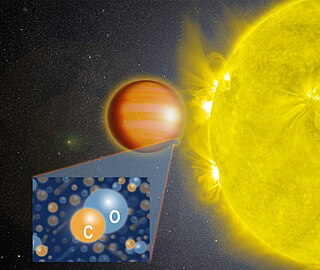
WASP-1b is an extrasolar planet orbiting the star WASP-1 located 1,300 light-years away in the constellation Andromeda.

WASP-4b is an extrasolar planet approximately 891 light-years away in the constellation of Phoenix.

WASP-5b is an extrasolar planet orbiting the star WASP-5 located approximately 1000 light-years away in the constellation Phoenix. The planet's mass and radius indicate that it is a gas giant with a similar bulk composition to Jupiter. The small orbital distance of WASP-5 b around its star mean it belongs to a class of planets known as hot Jupiters. The equilibrium planetary temperature would be 1717 K, but measured in 2015 temperature was still much higher at 2500±100 K. Dayside temperature measured in 2020 was 2000±90 K.
WASP-10 is a star in the constellation Pegasus. The SuperWASP project has observed and classified this star as a variable star, perhaps due to the eclipsing planet.

HD 80606 b is an eccentric hot Jupiter 190 light-years from the Sun in the constellation of Ursa Major. HD 80606 b was discovered orbiting the star HD 80606 in April 2001 by a team led by Michel Mayor and Didier Queloz. With a mass 4 times that of Jupiter, it is a gas giant. Because the planet transits the host star its radius can be determined using the transit method and was found to be slightly smaller than Jupiter's. Its density is slightly less than Earth's. It has an extremely eccentric orbit like a comet, with its orbit taking it very close to its star and then back out very far away from it every 111 days.

WASP-14b is an extrasolar planet discovered in 2008 by SuperWASP using the transit method. Follow-up radial velocity measurements showed that the mass of WASP-14b is almost eight times larger than that of Jupiter. The radius found by the transit observations show that it has a radius 25% larger than Jupiter. This makes WASP-14b one of the densest exoplanets known. Its radius best fits the model of Jonathan Fortney.
WASP-3 is a magnitude 10 yellow-white dwarf star located about 800 light-years away in the Lyra constellation. It appears to be variable; it "passed from a less active to a more active state between 2007 and 2010".
HAT-P-13, also known as GSC 03416-00543, is a G-type main sequence star approximately 800 light-years away in the constellation Ursa Major. In 2009 it was discovered that this star is orbited by two massive planets, the innermost of which transits the star. This was the first known example of an extrasolar transiting planet with an additional planet in the same system.
WASP-17 is an F-type main sequence star approximately 1,300 light-years away in the constellation Scorpius.

WASP-18b is an extrasolar planet that is notable for having an orbital period of less than one day. It has a mass equal to 10 Jupiter masses, just below the boundary line between planets and brown dwarfs. Due to tidal deceleration, it is expected to spiral toward and eventually merge with its host star, WASP-18, in less than a million years. The planet is approximately 3.1 million km from its star, which is about 410 light-years from Earth. A team led by Coel Hellier, a professor of astrophysics at Keele University in England, discovered the exoplanet.
WASP-18 is a magnitude 9 star located in the Phoenix constellation of the southern hemisphere. It has a mass of 1.25 solar masses.
WASP-19 is a magnitude 12.3 star located in the Vela constellation of the southern hemisphere. This star has been found to host a transiting hot Jupiter-type planet in tight orbit.
WASP-33b is an extrasolar planet orbiting the star HD 15082. It was the first planet discovered to orbit a Delta Scuti variable star. With a semimajor axis of 0.026 AU and a mass likely greater than Jupiter's, it belongs to the hot Jupiter class of planets.

Transit-timing variation is a method for detecting exoplanets by observing variations in the timing of a transit. This provides an extremely sensitive method capable of detecting additional planets in the system with masses potentially as small as that of Earth. In tightly packed planetary systems, the gravitational pull of the planets among themselves causes one planet to accelerate and another planet to decelerate along its orbit. The acceleration causes the orbital period of each planet to change. Detecting this effect by measuring the change is known as transit-timing variations. "Timing variation" asks whether the transit occurs with strict periodicity or if there's a variation.
WASP-24 is an F-type star with the Hot Jupiter planet WASP-24b in orbit. WASP-24 is slightly larger and more massive than the Sun, it is also has a similar Metallicity and is hotter than the Sun. WASP-24 was first observed by the SuperWASP planet-searching organization, which flagged it as a potential host to a planet before following up with radial velocity and spectral measurements. Analysis of these confirmed the planetary nature of WASP-24b, which was later released to the public on the SuperWASP website.
WASP-44 is a G-type star in the constellation Cetus that is orbited by the Jupiter-size planet WASP-44b. The star is slightly less massive and slightly smaller than the Sun; it is also slightly cooler, but is more metal-rich. The star was observed by SuperWASP, an organization searching for exoplanets, starting in 2009; manual follow-up observations used WASP-44's spectrum and measurements of its radial velocity led to the discovery of the transiting planet WASP-44b. The planet and its star were presented along with WASP-45b and WASP-46b on May 17, 2011 by a team of scientists testing the idea that hot Jupiters tend to have circular orbits, an assumption that is made when the orbital eccentricity of such planets are not well-constrained.
WASP-66, also known as TYC 7193-1804-1, is an F-type star in the constellation Antlia. It has an apparent magnitude of 11.6, which is much too faint to be seen with the unaided eye and is located at a distance of 1,630 light years.
HD 146389, is a star with a yellow-white hue in the northern constellation of Hercules. The star was given the formal name Irena by the International Astronomical Union in January 2020. It is invisible to the naked eye with an apparent visual magnitude of 9.4 The star is located at a distance of approximately 446 light years from the Sun based on parallax, but is drifting closer with a radial velocity of −9 km/s. The star is known to host one exoplanet, designated WASP-38b or formally named 'Iztok'.
WASP-25 is a yellow main sequence star in the constellation of Hydra.
WASP-61 is a single F-type main-sequence star about 1560 light-years away. The star age is much likely younger than the Sun's at approximately 3.8+1.8
−0.9 billion years. WASP-61 is depleted in heavy elements, having just 40% of the solar abundance of iron.







